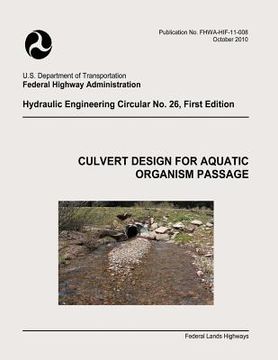Synopsis "Culvert Design for Aquatic Organism Passage"
This manual presents a stream simulation design procedure, methods and best practices for designing culverts to facilitate aquatic organism passage (AOP). Although this manual focuses on culverts, the design team should recognize that an appropriate structure for any given crossing may be a bridge. This manual is not intended to conflict with or replace accepted guidance and procedures adopted in particular locations. When specific water crossing design methods are required in the jurisdiction where the crossing is located, those methods should be applied. In addition, local and regional requirements may overlay additional steps on this design approach. Since fish have been the primary focus of AOP design efforts over the years, and much has been learned about fish specifically, many of the references to AOP in this manual derive directly from what is known about fish. However, the broader scope of AOP is the focus of the manual. Because of the variety of fish and other aquatic species in the U.S., the complex nature of fish behavior, and the variation in such behaviors and capabilities over the various life-stages, designing hydraulic structures with satisfactory aquatic organism passage (AOP) characteristics remains a challenging endeavor. Over the years, resource agencies and others have assembled a large amount of empirical data and field experience to guide the design of roadway structures, particularly culverts, for passage. Much of the resulting criteria are based upon the natural geomorphic characteristics of streams supporting the aquatic ecosystems of interest, and many of the procedures implementing those criteria seek to replicate the stream and floodplain characteristics and geometries within the roadway crossing structure. The "stream simulation" approach such as developed by the United States Forest Service (FSSWG, 2008) is one approach that is state of the art. Given the diverse behavior and capabilities of fish and other aquatic organisms, design procedures necessarily rely on surrogate parameters and indicators as measures for successful passage design. Many of the existing AOP design procedures rely on dimensional characteristics of the stream such as bankfull width. A critique of the use of dimensional stream characteristics is that they: 1) can be difficult to identify, 2) can be highly variable within a stream reach, 3) assume the stream is in dynamic equilibrium, and 4) have no known relationship to passage requirements. The procedure described in this manual uses streambed sediment behavior as its surrogate parameter. The hypothesis of using sediment behavior as a surrogate parameter is that aquatic organisms in the stream are exposed to similar forces and stresses experienced by the streambed material. The design goal is to provide a stream crossing that has an equivalent effect, over a range of stream flows, on the streambed material within the culvert compared with the streambed material upstream and downstream of the culvert. When this is achieved and the velocities and depths are comparable to those occurring in the stream, the conditions through the crossing should present no more of an obstacle to aquatic organisms than conditions in the adjacent natural channel. The primary goal of this document is to incorporate many of the current geomorphic-based design approaches for AOP while providing a procedure based on quantitative best practices. The stream simulation design procedure is intended to create conditions within the crossing similar to those conditions in the natural channel to provide for aquatic organism passage (AOP). This document seeks to identify, develop, and present a bed stability-based approach that accounts for the physical processes related to the natural hydraulic, stream stability, and sediment transport characteristics of a particular stream crossing as surrogate measures.

